A short stay in Milan
I recently wrote about my skiing holiday in Madonna di Campiglio, a village and ski resort in Northern Italy. I combined my holiday with a few days in Trento and Milan.
Trento, the gateway to Madonna di Campiglio, is an hour and a half by train from Verona, and two hours and a half from Milan, the second-largest city in Italy and capital of Lombardy. Since I’d been to Verona before, and considering that there are far fewer international flights to Verona than to Milan, I decided to fly to Milan and spent the night there.
The following day, I took the train to Trento, where I spend another night. I then made my way to Madonna di Campiglio. After my ‘settimana bianca’, I returned to Trento for another night, and from there to Milan (for yet another night), before eventually making my way back to London.
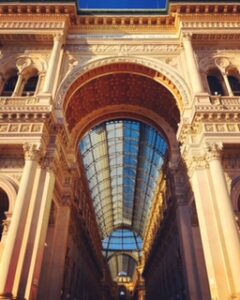
“Pre-ski” in Milan
I flew to Malpensa Airport, Italy’s second-busiest airport, located 45 km from Milan city centre. From Malpensa, there are trains to Milano Centrale train station every 30 minutes. The journey takes about 50 minutes (13 euros one-way). As well as Malpensa, there’s also Linate Airport (located less than 8 km from Milan city centre) and Orio al Serio Airport (located 50 km away, near the town of Bergamo). The latter mainly serves the low-cost traffic of Milan and it is the main base of Ryanair.
I had dinner (pizza of course) at Berberè Pizzeria in Isola, a neighbourhood very close to Milano Centrale, the main railway station of the city (and the largest in Europe). Berberè first opened in 2010 in Castel Maggiore, a town close to Bologna. Nowadays, they have 15 locations in (mostly Northern) Italy and two in London (in Clapham and Kentish Town). Afterwards, I had a couple of cocktails at the nearby Botanical Club, a ‘Wild Roots’ (vermouth, mastic, rum) and a ‘Stranger Mule’ (gin, lime cordial, ginger beer, purple bitter).
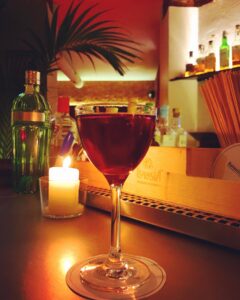
The following morning, I had coffee and breakfast at Pave, a lovely café close to Milano Centrale (a 10-minute walk). Afterwards, I took the train to Trento, where I arrived early in the afternoon (29 euros one-way).
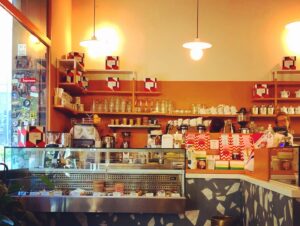
“Après-ski” in Milan
After my ‘settimana bianca’, I returned to Trento for another night. On the following morning, I took a direct train to Milan (18 euros one-way).
The ‘Golden Quad’ (Quadrilatero d’Oro)
I arrived in Milan at noon. After settling in the hotel, I ventured out to explore the capital of Lombardy (and fashion). I first headed to the ‘Golden Quad’ (Quadrilatero d’Oro). Also known as Quadrilatero della Moda, this high-end shopping district is loosely bound by Via Alessandro Massoni, Via Seneto, Via Sant’Andrea and Via Monte Napoleone. At the intersection between the latter and Via Sant’Andrea, there’s Cova, a historical pasticceria founded in 1817. It was originally next to the Scala, but has been in its present location since 1950. Despite being a pasticceria, they also serve savoury dishes. I treated myself to a sacher torte (a rather popular cake in Northern Italy) and a ‘1817’ (Bitter Campari, antica ricetta Carpano, Covino sparkling wine, Aperol, Martini Bianco, Vodka).
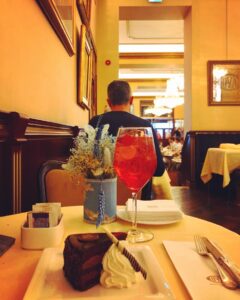
Galleria Vittorio Emanuele II and the Duomo
Afterwards, I set out to explore some of the city’s landmarks and famous churches. After a visit to the Chiesa di San Fedele, I continued to Piazza della Scala. As the name suggests, here’s the famous opera house ‘Teatro alla Scala’. There’s also one of the four entrances to the Galleria Vittorio Emanuele II. Named after Victor Emmanuel II, the first king of the Kingdom of Italy, the Galleria is housed within a 19th-century, glass-covered, four-story double arcade. I walked through the elegant but crowded Galleria passing by fashion boutiques, restaurants, bookshops and gelaterias. I exited into the no less crowded Piazza del Duomo. The Duomo, short for Basilica cattedrale metropolitana di Santa Maria Nascente, is the city’s cathedral and the largest church in the Italian Republic. The standard ticket costs 7 euros.

From the Duomo, I walked on Via Orefici, which later becomes the rather touristy Via Dante, towards the Castello Sforzesco, a Medieval-Renaissance fortress and another landmark of the city. I turned left on Via Meravigli and stopped for a coffee at Pasticceria Marchesi, at the intersection with Via Santa Maria della Porta. This is another historical pasticceria, founded in 1824. There are currently two more Marchesis, one on Via Monte Napoleone, and another one in the Galleria Vittoria Emanuele II. The latter is located above one of the Prada boutiques, with the entrance next to the bookstore Feltrinelli.
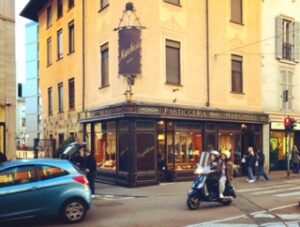
The churches of San Maurizio and Sant’Ambrogio
Caffeinated, I continued to the Chiesa di San Maurizio al Monastero Maggiore on Corso Magenta. This 16th-century church was born as the worship hall of a Benedictine convent. For this reason, it was divided into two parts, a cloistered hall for the nuns and one for the public. The two halls are separated by a transverse wall with a central screen through which the sisters participated in the functions celebrated in the public sanctuary. The church is renowned for the frescoes painted by Bernandino Luini in the early 1500s. Nowadays, there are no longer any nuns, but there are classical music concerts taking place in the church (on Saturday evenings). Outside of those days, the church is open from Tuesday to Sunday from 10 am to 5.30 pm and is free to enter.
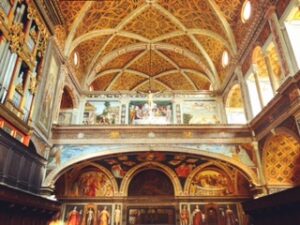
Next to it, there is also the Civico Museo Archeologico (Milan’s Archaeological Museum). Instead of visiting the museum, I made a detour towards the Basilica di Sant’Ambrogio, dedicated to the city’s patron saint.
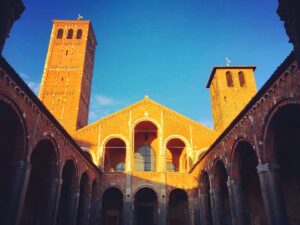
The Last Supper (Leonardo’s)
Afterwards, I walked back to Corso Magenta until I arrived at the Basilica di Santa Maria delle Grazie. I had already purchased a ticket to visit the Museo del Cenacolo Vinciano to admire the ‘Last Supper’. Leonardo da Vinci’s mural masterpiece was painted in the late 15th century. The standard ticket costs 15 euros. Entry to the Basilica is free. Whilst waiting for my slot (I had to collect my ticket 45 minutes earlier), I had a gelato from Fatto Con Amore (on Corso Magenta, almost opposite San Maurizio). It was an unusually hot March day, and all the gelaterias had long queues (luckily, I did not have to wait for too long).
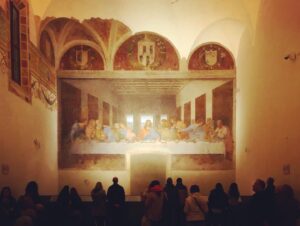
The Last Supper (Alessandro’s)
After my visit to the Museo del Cenacolo Vinciano, I walked towards the navigli, Milan’s interconnected canals. I strolled along Naviglio Grande, lined mostly with bars and restaurants (as well as a few shops). As it was a warm Saturday evening, it was buzzing with people having an aperitivo by the canal. I then made my way back towards the Duomo. I passed by the Arco di Porta Ticinese, an impressive 19th-century gate, then by the Basilica di Sant’Eustorgio. Further up on Corso di Porta Ticinese, I passed under the 12th-century Porta Ticinese Medievale and then took a few moments to admire the Basilica San Lorenzo Maggiore.
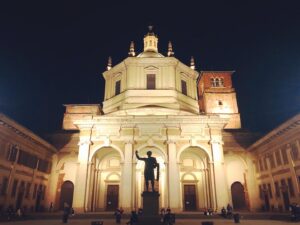
During my walking tour, I realised that Italy’s second-largest city is not only a vibrant and lively metropolis, but also home to a large number of elegant restaurants and bars (not that I had had any doubt). Yet, this was my last night in Italy and after all the fine dining and wine tasting in Trentino, I craved pizza and beer. So, I decided to play it safe (at the end of the day, it was Saturday night and had made no dinner reservations) and made my way to Berberè Colonne (on Corso di Porta Ticinese).
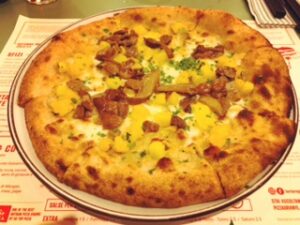
The following morning, I started my day with a rather short walk around the hotel. Passing by the Chiesa di Sant’ Angelo, I visited the Chiesa di San Marco, then continued to the Basilica di San Simpliciano. Afterwards, I had brunch at oTTo, before taking the train from Garibaldi Station to Malpensa Airport.
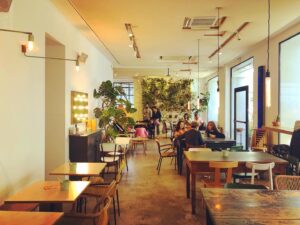
Where to stay in Milan
I stayed at Aparthotel Porta Nuova. I had a lovely apartment located almost halfway between Milano Centrale (a 15-minute walk) and the Duomo (a 20-minute walk).
Further reading
To better prepare for my trip in Rome, I used the Lonely Planet Italy Travel Guide.
To read more about my skiing holiday in Madonna di Campiglio, check out my previously published post.
Alex
(the Traveling Psychiatrist)